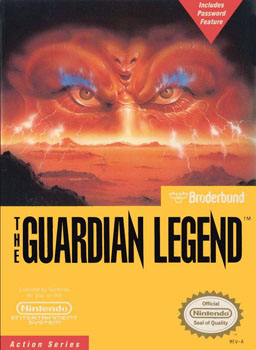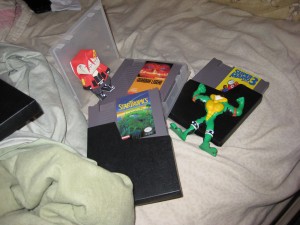This one’s been a long time coming.

Anyone who’s been a reader for a good while here knows that I toss out the fact The Guardian Legend was my favorite NES game pretty much any chance I get. So to those who have been waiting and expecting it, here we are- and what do you know, 2013 marks the 25th anniversary of this semi-hidden NES gem. Here’s to you.

When I was a kid, I spent about as much time coveting TGL as I did actually playing it. My friend had a copy at his house and was showing it off one day, and something about the graphics and music just enraptured my little brain. I played it over there frequently, and rented it from Blockbuster enough times to probably equal the cost of the game. One day, when I was out shopping with my family at Service Merchandise (sadly, they closed their doors as a retailer and just sell stuff online now, but back then they had like the best toy section), I found a copy in a bin. Must have been used or something, now that I think about it, since I remember it coming in one of those plastic boxes rather than the real box. But who cares, it was my copy of a game I’d already loved for years.
For those who aren’t long time readers and don’t feel like going back and looking, or if you’re totally oblivious the the game, TGL was a rare hybrid of a game that combined Zelda-esque exploration sections with intense overhead shooter segments. Sounds easy, right? Oddly, it’s been pretty rarely attempted, and when it has, it’s never been executed quite the same way as the first. Sigma Star Saga and to an extent, Lunar Knights are the only ones that spring to mind as taking halfway similar approaches, but neither have the right feel. That’s probably a big factor of why I hold the game up so much, as much as on its own virtues, but if it had caught on, think of the amazing games we could have gotten if other people had picked up where it left off and improved on it?
(By the way- if anyone knows of any TGL-ish games I omitted aside from fan remixes, by all means, leave a comment. Love to try ’em out.)
In this game, you take on the role of the Guardian, (alias Alyssa, alias Miria) a ‘sophisticated aerobot transformer,’ charged with finding and triggering the self-destruct mechanisms on the artificial planet Naju, which is on a collision course with Earth. To accomplish that goal, you must roam about the planet’s surface in search of Corridors leading to bosses who are either guarding, or actually are the self-destruct devices themselves. Always been a little fuzzy on that point, honestly. At any rate, you’re in control of a girl in an armored battle-kini who can transform into a freaking fighter jet. At first I thought that it was just a graphical thing, or she was jumping in an out of the jet, but nope- she leaps into the Corridor, twirls about, and has an animation showing the transition from humanoid to jet. If you watch her barrel-rolling/damage animation, too, you’ll notice that you can even see her face on the underbelly of the ship! It’s always been a fascinating detail to me, because it’s the sort of thing most animators would either cover up or avoided showing in the first place (i.e.; taking the lazy way out and not showing the animation altogether in favor of ‘zapping’ her from one form to another, or simply cutting from the Corridor chamber straight to the shooting section.) I won’t lie- the main character’s design is a nice chunk of the game’s appeal to me, but there’s still plenty more to love.
In writing the MY Games stuff so far, I’ve noticed a recurring theme in games that really grabbed me using RPG-like mechanics long before I had the attention span to appreciate actual RPGs. What do you know, The Guardian Legend does that too. It was no big deal for old arcade style shooters to grant you an extra life after scoring so many points, but TGL’s joining the shooter segments together with a Zelda-like overworld meant you had one, persistent ‘life’ (which you could restore through a long and utterly terrible password system.) So, how does a unique “shooter†like this reward the player for achieving high scores? Your maximum health increases, with a satisfying little jingle. Yes- your POINTS are actually experience points in disguise! Devious. You can also collect items to give you permanent upgrades to your health, damage dealing potential, and Power Chip supply (for sub weapons, which are in turn upgradeable to an extent.) There are a few “shops†staffed by the cheery Compile mascot, Lander/Randar which will offer you a choice of items in exchange for Chips, so if you have a favorite subweapon, you can ‘stack’ it up to three times in order to increase its power and usually amplify whatever special effects it has.
Another little thing I always liked were the logs left behind by some unseen benefactor. Few NES games were what you could call really well written. Most of the time, “coherent†was enough. But TGL offered a rather somber, indirect narrative when you think about it. You’ve been given an order to destroy a planet to save your own, and upon arriving, you are greeted by a room sized screen that says “If you are reading this… then I must have failed.†As you trek about (or exploit a glitch in the first room of the game, ahem) you find more cryptic notes giving you hints on how to open some of the more stubborn Corridor doors, not unlike the audio tapes dotting many a game’s landscape to offer tips or just add to the atmosphere. Your predecessor says he was one of the original inhabitants of Naju before it was invaded by hostile life forms. Given that the only other friendly beings you find are the roly-poly Landers, I always had a weird mental picture of an overly-serious Lander making his way across Naju with a knife gripped in his teeth (since he has no arms for guns and all.)
Course, no game is perfect. TGL is a grueling game to actually play through, and most of my (non cheaty) attempts usually end just after the Forest zone. The game has something of a difficulty imbalance in between its shooting and exploration portions- you can really tell that Compile was more interested in the shooter segments, which are a lot like a more refined version of Zanac. (Which I guess makes them kind of like GunNac?) The overworld segments, by contrast, you can more or less wade through effortlessly unless you take your sweet time farming chips and gathering upgrades. Enemies ‘fade’ onto the screen when you enter a room, and you have a rather generous amount of time to run over to the other side before they finish materializing and become able to deal damage. Even minibosses appearing in the Labyrinth can simply be brushed off by exiting their area before the blocks that seal off their ‘arena’ finish appearing. I know, it’s a nitpick, but it’s a pretty obvious lack of attention when you consider inputting “TGL†at the password screen allows you to play through a “secret†version of the game that skips the Labyrinth entirely and just awards you seemingly arbitrary upgrades between shooter levels. The difficulty gap also serves as something of a sucker punch to people who aren’t so hot at shooters- the number of enemies and projectiles on screen approaches Bullet Hell levels at times, before Bullet Hell was really a thing. Even if many projectiles are destructible, you’re going to be very glad you have an actual life bar instead of the genre-standard one-hit death.
Oh yes, the password screen. God, thats an aspoect of old games I don’t miss a lick. TGL’s password screen was one of those needlessly complex ones that included upper and lowercase letters along with numbers for extra confusion. Half the reason I devoted whole afternoons to the game was the frustration I knew I’d experience if I mistook an “O†for a “0†after fighting one of those stupid eyeball-lobbing bosses from the organic-themed dungeon. Thankfully, through the magic of emulators and save states and so on, I can enjoy the game with the illusion of modern, convenient stopping points.
So, all of that said, let’s finally hit on the point of the column- How did this game influence me? Well, for one, it taught me anime chicks in robot armor are freaking sweet, and I didn’t even know what anime was yet. (In fact the whole reason I got into the likes of Robotech and stuff as a grade-schooler was because the artwork reminded me of how they drew people in Nintendo cutscenes.) It gave me an appreciation for free-roaming exploration and character customization, even if the ‘puzzles’ tended to amount to “Got the key with this symbol on it yet? No? Then you can’t enter this warp panel.†Really, I think the best way to sum this whole thing up is just that it hit most of my basic interests just so and as a result, the whole product feels oh-so right. The explosions, the sound effects, the awesomely catchy music, the coherence of enemies within a given environment (for the most part), all of it just works for me. It might be one of those lightning in a bottle things, and nothing else’ll quite replicate the magic of the original.
But couldja try? Konami*? Someone?
*Seriously, Lunar Knights probably came closest to what I’d like the Labyrinths to be like in a remake or successor. Shame the shooting segments were based on an engine that prevents you from moving and shooting simultaneously.

